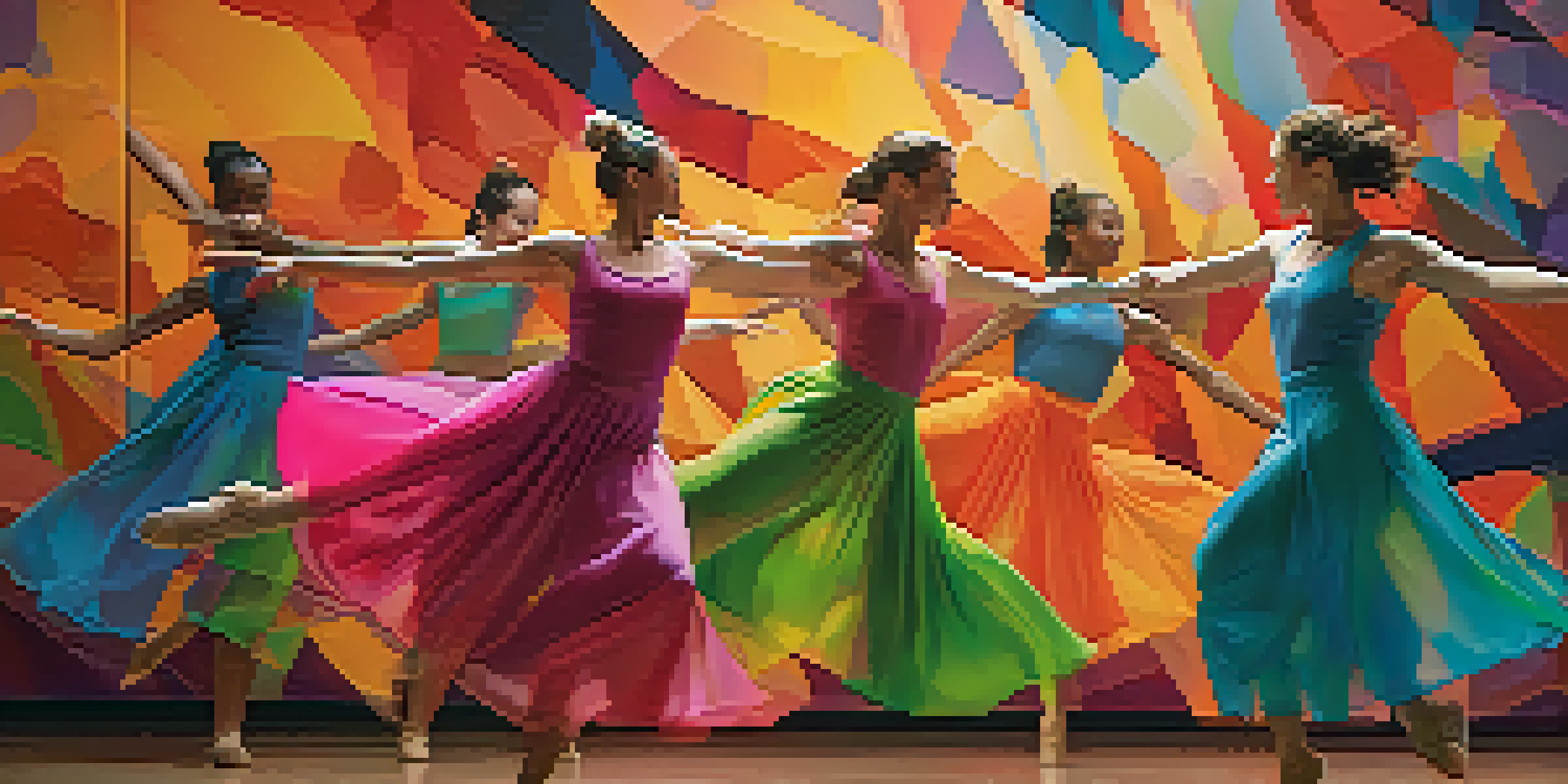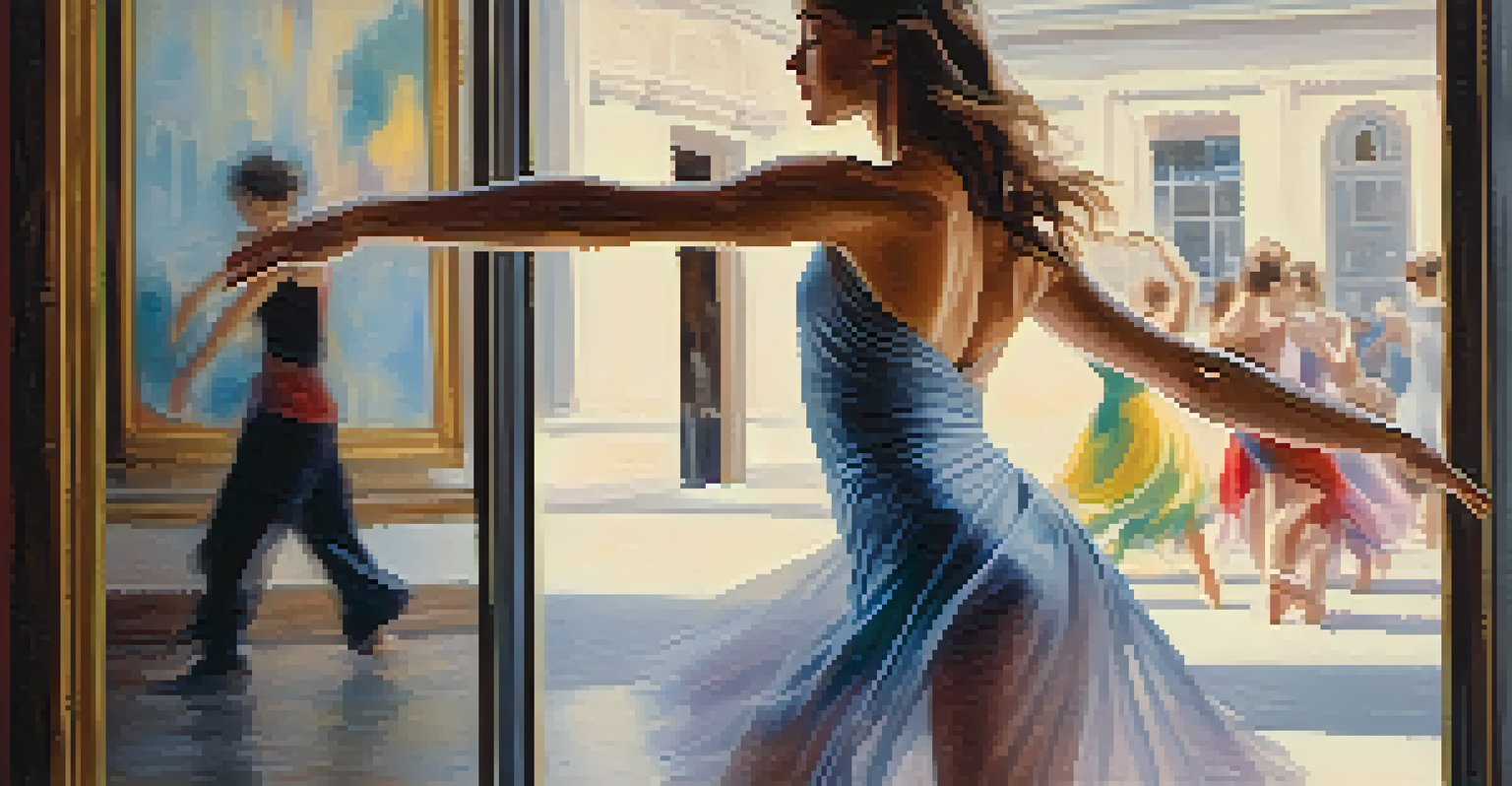Visual Arts as a Source of Inspiration for Dance Choreography

The Connection Between Visual Arts and Dance
Visual arts and dance have a unique relationship that often inspires choreographers. Both art forms express emotions and ideas through movement and imagery, creating a dialogue that transcends traditional boundaries. Just as a painting can evoke feelings, so can a dance piece, allowing for a rich interplay between the two mediums.
Dance is the hidden language of the soul.
Choreographers frequently draw from visual artworks to spark their creativity. For example, a vivid painting might inspire a dance's color palette, while a sculpture's form could influence the dancers' movements. This synergy not only enriches the choreography but also deepens the audience's experience as they witness the translation of visual art into kinetic expression.
Moreover, the process of interpreting visual art through dance encourages innovation. Dancers might explore how to embody a piece of art, considering how to convey its essence through their bodies. This exploration ultimately leads to fresh and dynamic performances that challenge both the artists and their audiences.
Famous Collaborations Between Visual Artists and Dancers
Throughout history, numerous collaborations between visual artists and dancers have produced remarkable works that push creative boundaries. A notable example is the partnership between choreographer Martha Graham and artist Isamu Noguchi. Their joint efforts resulted in groundbreaking productions that seamlessly integrated sculpture and movement, creating an immersive experience for viewers.

Another significant collaboration is between choreographer Merce Cunningham and visual artist Robert Rauschenberg. Rauschenberg’s innovative set designs and costumes transformed Cunningham's performances, allowing the dancers to inhabit a world that was both visually stunning and conceptually rich. This fusion of art forms not only captivated audiences but also inspired future generations of artists.
Visual Arts Inspire Dance Choreography
Choreographers often draw inspiration from visual artworks, translating their emotional and aesthetic qualities into movement.
These collaborations illuminate the powerful impact of visual arts on dance choreography. When artists from different disciplines come together, they create a vibrant tapestry of creativity that can challenge conventions and invite audiences to see both art forms in a new light.
Emotional Expression Through Visual Art
Visual arts excel at conveying emotions, a quality that choreographers often seek to replicate in their work. A powerful painting can evoke sadness, joy, or nostalgia, prompting dancers to explore these feelings through movement. By tapping into the emotional core of visual art, choreographers can create performances that resonate deeply with audiences.
Art is not what you see, but what you make others see.
For instance, a dancer interpreting a melancholic piece might choose slow, fluid movements that mirror the brushstrokes of a somber artwork. This connection between visual emotions and physical expression allows for a richer storytelling experience. Audiences can feel the pulse of the original artwork in the choreography, creating an emotional bridge between the two forms.
Ultimately, the emotional depth found in visual art can serve as a powerful catalyst for dance. By examining and embodying these feelings, choreographers can craft performances that not only entertain but also evoke reflection and connection within their audiences.
Using Color and Form as Choreographic Tools
Color and form are fundamental elements in visual arts that can greatly influence dance choreography. Choreographers often use these elements to create mood and atmosphere within their pieces. For example, bright colors may inspire energetic and lively movements, while muted tones could evoke a more introspective performance.
The shapes and lines found in visual art can also inform the structure of a dance. A choreographer might analyze the angles and curves of a sculpture, translating these physical forms into the shapes created by dancers' bodies. This exploration of visual language enables artists to merge the two disciplines seamlessly.
Collaborations Enrich Artistic Expression
Notable partnerships between visual artists and choreographers have led to innovative performances that merge sculpture and movement.
By consciously incorporating color and form into their choreography, dance artists can enhance the visual impact of their performances. This approach not only captivates the audience’s attention but also reinforces the connection between the movement and the underlying artistic inspiration.
Incorporating Storytelling from Visual Arts
Storytelling is a common thread that runs through both visual arts and dance. Many artists create narratives through their paintings or sculptures, which can provide fertile ground for choreographers seeking inspiration. By interpreting these stories through movement, dancers can bring a visual narrative to life on stage.
For instance, a choreographer might choose a series of paintings that depict a journey, using each piece to inspire different sections of the dance. This approach allows for a cohesive narrative that evolves as the performance unfolds, drawing the audience into the story in a dynamic way. It also highlights the versatility of dance as a storytelling medium.
Moreover, incorporating storytelling from visual arts can deepen the audience's engagement with the performance. As spectators recognize familiar themes or characters from the artwork, they become active participants in the narrative, leading to a more immersive and memorable experience.
Exploring Cultural Narratives Through Art and Dance
Both visual arts and dance serve as cultural reflections, offering insights into societal values and histories. Choreographers can draw upon various cultural artworks to inform their choreography, allowing them to explore and celebrate diverse narratives. This exploration enriches the dance and fosters a deeper understanding of different cultures.
For instance, a choreographer might study traditional art forms from a specific culture, using the themes and motifs present in those works to inspire a contemporary dance piece. This blending of old and new not only honors the original art but also invites audiences to engage with cultural narratives in a fresh context.
Cultural Narratives Enhance Dance
Exploring cultural visual arts allows choreographers to celebrate diverse narratives, fostering deeper understanding and inclusivity in dance.
By connecting dance with cultural visual arts, choreographers can bridge gaps between communities and promote inclusivity. This approach encourages an appreciation for the richness of diverse artistic expressions, ultimately enhancing the overall experience for both the performers and the audience.
The Future of Dance Inspired by Visual Arts
As we move forward, the interplay between visual arts and dance continues to evolve, presenting exciting opportunities for innovation. With advancements in technology, artists can explore new ways to merge these two forms, such as interactive installations that incorporate dance performances. This fusion opens up endless possibilities for creative expression.
Choreographers are increasingly experimenting with multimedia elements, using video projections and digital art to enhance their performances. This integration not only enriches the visual experience but also challenges traditional notions of choreography, encouraging artists to think outside the box. The future of dance is likely to be shaped by these cross-disciplinary explorations.

Ultimately, the continued collaboration between visual arts and dance holds the potential to inspire and captivate audiences in ways we've yet to imagine. As artists push the boundaries of their respective disciplines, we can expect to see a vibrant landscape of creativity that celebrates the innate connection between these two powerful forms of expression.